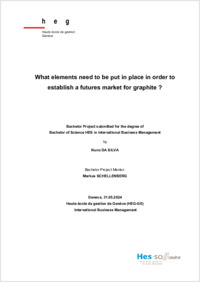What elements need to be put in place in order to establish a futures market for graphite ?
SONAR|HES-SO
- Da Silva, Nuno
- Schellenberg, Markus (Degree supervisor)
- Genève : Haute école de gestion de Genève
64 p.
Bachelor of Science HES-SO in International Business Management: Haute école de gestion de Genève, 2024
English
The development of new technologies and the increased use of batteries have significantly highlighted the importance of a mineral: graphite. This material, crucial for the anodes in lithium-ion batteries, is vital for the expanding electric vehicle (EV) market and other energy storage technologies. The primary aim of this research is to explore the potential for establishing a futures market for graphite, examining the feasibility and requirements for such a development. The study employs a framework that investigates the successes and failures of existing futures markets, applying these insights to the graphite market. By analysing the current state and dynamics of the graphite market, through interviews and other secondary data sources, the research seeks to identify how well it aligns with the established criteria for a successful futures market and what specific elements might be missing.
The graphite market analysis reveals several key aspects. The demand for graphite is set to rise due to its essential role in battery production. Graphite constitutes the largest component in lithium-ion batteries, surpassing even lithium in volume. Such batteries market is expected to grow, driven by the increased adoption of EVs and the global shift towards renewable energy storage solutions. Additionally, graphite's importance in electric arc furnaces (EAFs) highlights its role in achieving the steel industry's decarbonization goals, further boosting its demand. However, the market is heavily dependent on China, which dominates both natural and synthetic graphite production. This dependence makes the supply chain vulnerable to geopolitical risks and environmental concerns associated with China's production practices.
To successfully establish a futures market for graphite, it is crucial to standardize graphite quality. Research shown in this paper shows that the battery industry could serve as a bridge between natural and synthetic graphite, facilitating this standardization. Although graphite is a form of carbon, it is vital for decarbonizing the economy, supporting low-emission technologies and renewable energy systems. Therefore, as graphite trade is facilitated, environmental impacts must be considered, and production methods should aim for a low carbon footprint.
The graphite market analysis reveals several key aspects. The demand for graphite is set to rise due to its essential role in battery production. Graphite constitutes the largest component in lithium-ion batteries, surpassing even lithium in volume. Such batteries market is expected to grow, driven by the increased adoption of EVs and the global shift towards renewable energy storage solutions. Additionally, graphite's importance in electric arc furnaces (EAFs) highlights its role in achieving the steel industry's decarbonization goals, further boosting its demand. However, the market is heavily dependent on China, which dominates both natural and synthetic graphite production. This dependence makes the supply chain vulnerable to geopolitical risks and environmental concerns associated with China's production practices.
To successfully establish a futures market for graphite, it is crucial to standardize graphite quality. Research shown in this paper shows that the battery industry could serve as a bridge between natural and synthetic graphite, facilitating this standardization. Although graphite is a form of carbon, it is vital for decarbonizing the economy, supporting low-emission technologies and renewable energy systems. Therefore, as graphite trade is facilitated, environmental impacts must be considered, and production methods should aim for a low carbon footprint.
- Language
-
- English
- Classification
- Economics
- Notes
-
- Haute école de gestion Genève
- International Business Management
- hesso:hegge
- Persistent URL
- https://folia.unifr.ch/global/documents/330895
Statistics
Document views: 54
File downloads:
- BT_DASILVA_Nuno_2024.pdf: 72
